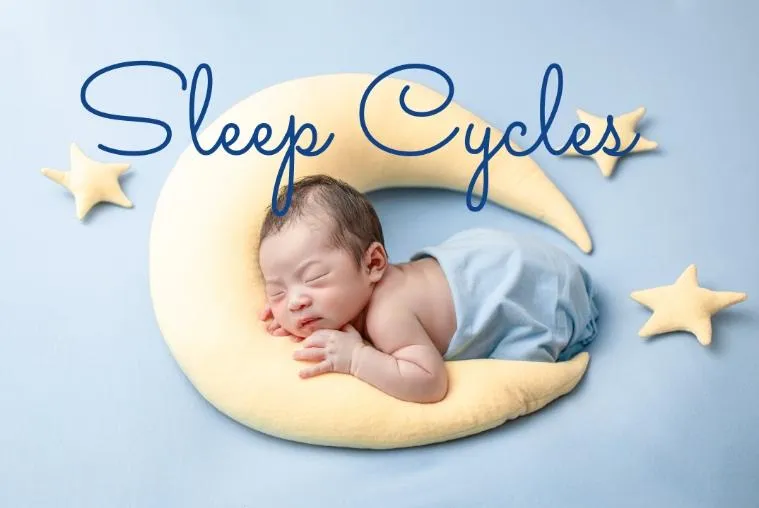
Sleep Cycles

💤 The Science of Sleep Cycles: Why It Matters for Your Child 🛏️
When it comes to your child’s sleep, it’s easy to get caught up in how much they’re sleeping, but what really matters is how they’re sleeping. That’s where understanding sleep cycles becomes so powerful.
At The Sleep Nanny®, we focus on personalised, responsive sleep solutions that support each family uniquely. And part of that support means helping parents understand the why behind their child’s sleep struggles, not just offering surface-level fixes. Understanding sleep cycles is a crucial part of that journey.
🌙 What Exactly Is a Sleep Cycle?
A sleep cycle is a recurring pattern the brain follows during sleep. Each cycle is made up of stages:
Stage 1 (Light Sleep) – This is the transition into sleep, where your child can be easily stirred.
Stage 2 (Deeper Light Sleep) – The heart rate slows, the body relaxes further, and your child starts to disconnect from the outside world.
Stage 3 (Deep Sleep or Slow-Wave Sleep) – This is the most restorative part of the cycle, where physical growth and immune system repair occur.
REM Sleep (Rapid Eye Movement) – This is when the brain becomes active again; dreaming happens here and memory consolidation takes place.
Adults experience 90–120-minute sleep cycles, but for infants and toddlers, the cycles are much shorter, typically 40–60 minutes, and even as short as 30–45 minutes in younger babies.
Each time a sleep cycle ends, a child enters a brief arousal period, and this is where sleep becomes fragile.

🧠 Why Does This Matter for Your Baby or Toddler?
These frequent arousals are completely natural. In fact, they’re protective, part of a survival mechanism that helps your baby stay responsive to hunger, discomfort, or environmental changes. But they also mean your child may fully wake between cycles if they don't yet have the ability to link cycles independently.
Understanding this can explain:
Short Naps: A baby who wakes after 30–45 minutes likely completed a full cycle but couldn’t resettle into another.
Frequent Night Waking: If your child needs external help (feeding, rocking, cuddling) to fall asleep, they’ll need it again with every cycle.
Early Morning Wake-ups: The last few sleep cycles of the night contain more REM and lighter sleep, easier to wake from.
Sleep is not just one long block, it’s repeated cycles, and your child’s ability to navigate them independently is a developmental skill.

🛏️ So, How Can You Support Sleep Cycles?
I guide families in creating personalised routines and environments that promote cycle-to-cycle connection. Here’s how you can support this at home:
1. Create a Calm, Predictable Bedtime Routine
A consistent routine signals to the brain that sleep is coming. It also promotes the release of melatonin, your child's natural sleepy hormone, and reduces stress hormones like cortisol.
Sleep routines are not about rigid schedules, they're about consistency and rhythm, which help babies feel safe and prepared for rest.
2. Watch for Age-Appropriate Wake Windows
Too much awake time can cause overtiredness, while too little may mean your child isn’t ready to sleep. Both can make transitioning between cycles harder. Learn your child’s ideal wake window (which changes with age).
3. Optimise the Sleep Environment
A dark, quiet room with white noise can help reduce arousals during lighter stages of sleep. This is especially helpful in the early morning when REM sleep dominates.
4. Practice “Pause and Observe”
Rather than rushing in the moment your child stirs, give them a few seconds. Sometimes what sounds like waking is actually your child transitioning through a cycle.
🧩 What If My Child Can’t Link Sleep Cycles?
This is one of the most common concerns I hear from families. The truth is, your child can learn this skill, and in most cases, it’s a matter of supportive habit-building rather than waiting it out.
The key is recognising that you don’t need to leave your baby to “cry it out”, and you don’t need to feel guilty for wanting more rest, either.
I believe that:
Sleep is a biological need, not a luxury
Parents deserve compassionate support
Children thrive when their emotional and physical sleep needs are met

💬 Want to Understand What’s Going on Beneath the Surface?
If you’re feeling stuck in a cycle of short naps, night waking's, or bedtime battles, it might be time to take a deeper look, without judgment and without pressure, as always. 💙
If you are ready to find out what's going on with your little one's sleep then use the link below, book yourself an evaluation call with me and lets try and unpick this together, and you can walk away with a report of the call to reflect on.
https://api.leadconnectorhq.com/widget/booking/T3LXcwc4ulIgGwoxCUgF
Katie Allan xx

